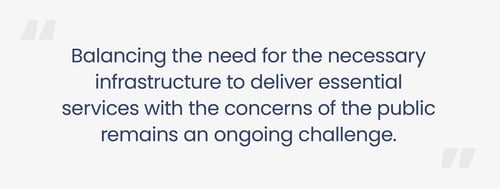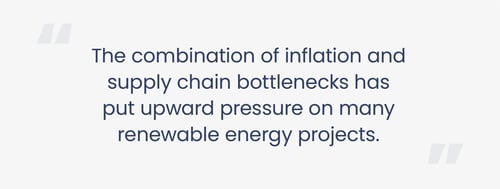We believe the passage of the Inflation Reduction Act (IRA) in 2022 marked a significant milestone in accelerating the transition to renewable energy generation. With its ambitious targets of reducing greenhouse gas emissions 33% by 2030 compared with 2005 levels and the allocation of up to $216 billion in tax credits for clean energy projects, we believe the IRA provides powerful incentives and a roadmap for renewable energy infrastructure development.
But the road ahead may not be without obstacles. Not everyone wants unsightly wind turbines or solar farms in their communities, supply chain complexities have increased the completion time of new projects, and inflationary pressures continue to impact labor and material costs. Higher interest rates are affecting both the cost of capital and the ability of developers to obtain financing. Each of these issues raises questions about whether the aggressive goals for increasing the amount of electricity generated by renewables will be met.

History of Overcoming Obstacles
In the United States, the development of large-scale infrastructure has historically led to conflict. In the 19th century, U.S. railways faced objections during their expansion across the continent from farmers concerned about property loss and disruptions to their livelihoods. While railroad expansion forever changed the grain industry by improving supply chains and the ability to bring products to market, many farmers and other private landowners objected to the railroads and refused to grant rights of way, resulting in delays and higher costs. Similar issues arose during the construction of the interstate highway system beginning in the 1950s.
More recently, wireless tower installations triggered opposition by individuals and communities worried that the large towers used to hang wireless hardware would cause negative aesthetic and environmental effects. However, the demand and expectation of many consumers for improved coverage and faster wireless service helped to overcome the not-in-my-backyard (NIMBY) outcry from many citizens. Balancing the need for the necessary infrastructure to deliver essential services with the concerns of the public remains an ongoing challenge. The transition to renewable energy is no exception.

Not In My Back Yard (NIMBY)
Today, the most common pushback to renewable development is coming from conflicted residents who often want to improve the environment, but not have the aesthetics or ecosystem where they live be disrupted. In New York and New Jersey, for example, over 20 humpback whales have washed up on its coastlines this year. This dramatic increase in whale deaths has brought heightened attention from environmentalists as well as local citizens seeking to understand why. A recent New York Times article quoted opponents of offshore wind turbines who believe the sonar used by energy companies to map the ocean floor for siting purposes could be the cause. The NOAA and the Marine Mammal Commission, however, say there is no evidence to substantiate this claim. Nonetheless, the conflict between wanting to improve the environment by lowering carbon emissions while not impacting the ocean’s ecosystem highlights one of the NIMBY challenges facing renewable development.
In the Midwest, similar conflict exists. Farmers are being approached by renewable developers to lease their land to develop renewable projects, but in Kansas some fear that the increase in wind development will forever destroy their communities. A Wall Street Journal report highlighted the owner of a Kansas family farm that grows corn, soybeans and raises cattle who doesn’t want to see her native forest and prairie impacted by large turbines. She lamented that “a year ago we were a nice quiet neighborhood,” but now has been forced to put up no trespassing signs on her property to keep developers away. Like the conflicts on the Atlantic coastline, the struggle between preserving ecosystems while lowering carbon emissions has and continues to impact the pace of expansion for renewables.
Other Obstacles
Supply chain issues present another challenge for renewable energy developers. A recent report from McKinsey & Company estimated that electricity generation from committed solar and wind projects, excluding China, will more than triple to 459 gigawatts by 2030. In the U.S., manufacturers of photovoltaic (PV) cells are trying to ramp up production as the supply of solar modules imported from overseas does not meet current demands and faces tariff and international trade risk. Installation of offshore wind turbines has also slowed due to the limited number of vessels available to both transport and install them.
The combination of inflation and supply chain bottlenecks has put upward pressure on many renewable energy projects. The large number of companies and governments seeking to purchase long-term contracts for wind and solar has created an imbalance between supply and demand for everything from materials and labor to transportation and permitting costs. Recent press reports speculate that developers in New York will soon be filing a formal petition with the state utility commission to request an inflation adjustment for projects already under contract in the state for onshore renewables.

To be sure, there are many deep-pocketed companies, such as NextEra Energy, leading the way in the expansion of green energy. On the other hand, companies with less supportive regulatory environments and management teams who struggle to address the risks to renewable and infrastructure will likely struggle to deliver on their renewable development goals. Consequently, their stocks may underperform those that can. For example, AVANGRID, the developer behind the single largest offshore wind farm in Massachusetts recently sought to have existing contracts amended and stated:
"AVANGRID has been clear, in evidence submitted to the Department of Public Utilities, that because of the aggregate impact of unprecedented global economic headwinds, including historic inflation, sharp increases in interest rates, and supply chain bottlenecks, the current Power Purchase Agreements (PPAs) do not allow the company to secure the significant financing needed to construct this critical project."
Opportunity is Large Despite Obstacles
Despite the many challenges that could potentially slow the progress of clean energy development, we believe renewable energy transition and the long runway of projects required to support it will continue to underpin the case for investing in utilities — a sector that is not only enabling this transition but, in some ways, leading it. By drawing on the experiences of past infrastructure projects, we’re confident initial roadblocks can—and will—be overcome and that our actively managed utility and infrastructure portfolios are poised to benefit.
With nearly 60 years of research and investing experience focused on utilities and essential services infrastructure companies, Reaves is no stranger to the hurdles that can impede large-scale power generation and transmission development. We apply our industry experience to analyze and assess the potential risks these hurdles create for renewable project developers within the context of the broader history of infrastructure development. By doing so, we can draw comparisons to the similar challenges many large-scale infrastructure projects, such as railways and wireless towers, faced in their development. Amid the current regulatory, political, and company-specific factors, we invest in companies our team believes can navigate the challenges facing renewable energy transition projects and deliver above-average earnings and dividend growth.
Stay up to date with our insights on developments impacting utilities and essential services infrastructure businesses. Subscribe to our blog and you’ll be among the first to receive recently published articles.


